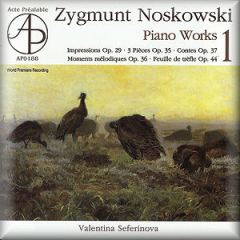Zygmunt Noskowski – Piano Works 1 (2008)
Zygmunt Noskowski – Piano Works 1 (2008)

1. Impressions - 4 Pieces caracteristiques Op. 29: I. En automne 2. Impressions - 4 Pieces caracteristiques Op. 29: II. Intermezzo 3. Impressions - 4 Pieces caracteristiques Op. 29: III. Dumka 4. Impressions - 4 Pieces caracteristiques Op. 29: IV. Cracovienne gracieuse 5. 3 Pieces Op. 35: I. Conte d'hiver 6. 3 Pieces Op. 35: II. Duma.. Une vielle romance 7. 3 Pieces Op. 35: III. Valse dolente 8. Moments melodiques Op. 36: I. Les larmes 9. Moments melodiques Op. 36: II. Gondoliera 10. Moments melodiques Op. 36: III. Chanson melancolique 11. Moments melodiques Op. 36: IV. Serenade du printemps 12. Contes Op. 37: I. Menuet lyrique 13. Contes Op. 37: II. Chant de berceau 14. Contes Op. 37: III. Mazourka ardente 15. Contes Op. 37: IV. Chansonnette d'hiver 16. Contes Op. 37: V. Caprice 17. Feuille de trefle Op. 44: I. Prelude meloncolique 18. Feuille de trefle Op. 44: II. Scherzo 19. Feuille de trefle Op. 44: III. Pensee fugitive Valentina Seferinova – piano
Yet another of the ever-burgeoning roster of rediscovered Polish compositional talent makes his ‘world premiere recording’ appearance on a label dedicated to just such an act of reclamation.
Noskowski was born in Warsaw and trained as a violinist before coming within the orbit of that pioneering spirit, Moniuszko with whom the fledgling composer studied singing and counterpoint. Feeling however that he lacked polish he went to Berlin to study composition. Eventually he returned to Warsaw where he became Professor of Composition as well as a choral and symphonic conductor of repute. Heart disease gradually curtailed his career and he died in 1909.
The first volume of Acte Préalable’s series devoted to him takes in his solo piano music. This, as well as songs and violin music - chamber music in toto in fact - is a particularly useful feature of this label’s exploratory work. None of these works are dated though I would guess that they come from the 1890s. The Impressions are character studies of some imaginative sweep. The first is a wind study called Autumn, with lots of arpeggios and then comes a rather salonised middle section; hints of late Liszt here. The terse outer sections of the second study enclose a puckish and rhythmically vivacious B section, whilst No.3 is a charming salon Dumka.
Of the 3 Pièces Op.35 it’s best to refer the first to the first of the Op.29 Impressions which it somewhat resembles in mood. It’s a song without words really, not really a nature picture. In the Duma there are hints of Chopin but also an individualistic Ballad strength which grows increasingly ripe. Though it’s marked dolente the Valse is actually quite fulsome in this performance by Valentina Seferinova, a Bulgarian pianist now resident in Britain.
These short collections show idiomatic skill and some striking moments. There’s slightly too much hectoring amidst the melancholy of the first of the Op.36 Moments mélodiques and the Gondoliera is a very straight ride indeed - abandon hopes of Reynaldo Hahn and sensuality. Still the third of the set is touchingly done before Noskowski reaches for another seasonal piece - Spring this time - to end the cycle; and it’s duly perky and fresh.
Contes must have been written almost immediately after the earlier cycle and reprises things. There’s lyric ease, a salon Berceau, and a gift for lyricism and charm, if without overmuch depth. The last cycle here is the Op.44 Feuille de trèfle. The first is quite tough and Seferinova sounds a little stretched by its demands. The third and last alternates between Schubertian influence and possibly a touch of Anton Rubinstein.
All these cycles are presented in chronological order, but there’s no great marked stylistic advance - which is not a criticism, merely an observation. The performances are enjoyable and the presentation and recording in the studio of Polish Radio Station S1 not too chilly. ---Jonathan Woolf , musicweb-international.com
download (mp3 @320 kbs):








